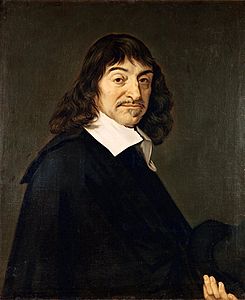René Descartes
From Geography
René Descartes was born in La Haye, France on the 31st of March, 1596, died 11th February 1650. Descartes attended boarding school at the Jesuit college at La Fleche, before studying at the University of Poiters around 1615-1616, where he achieved a degree in Law. In 1618 Descartes become a volunteer for the army of Maurice of Nassau. Here Descartes met Isaac Beekman. Beekman was said to have renewed Descartes interest in science and maths, and how he may apply these to other fields. This was a turning point for Descartes, however it was in November 1619 when stationed at Ulm and had three dreams that inspired him to seek for a new method for scientific inquiry.
From this, Descartes published "Discourse On Method" where he attempts to establish a new set of ideas that are without doubt. its here that Descartes published his best known quote "Cogito, ergo sum" or "I Think, Therefor I Am." When starting to attempt to establish his new ideas, he began with this, as he first discovered Though Exists, and thought could not be separated from himself, therefore he concluded that he existed. Also he realised his doubts showed his existence as he construed that to have doubts, someone or something must be doubting, he was and therefore he existed. Descartes did not agree with Scholastic philosophy, he thought it was too reliant on the senses and thought the senses were unreliable. He tried to prove the unreliability of the senses by noting how his senses changed towards a candle before and after it was lit. he concluded that to fully embrace the candle, his senses had to be put aside. Descartes also believed in the external world and argued against those who were skeptical about it. Today Descartes works are still being used and he has been referred to as the "father of modern philosophy" as he provided a new philosophy of his time, different to any other at that time.
Descartes and geography
René Descartes was not a geographer, but by postulating the dualism of res extensa (matter) and res cogitans (mind) he tried to solve, or at least to cope with, a problem that is also fundamental to geography (Zierhofer, 2002,p.1356). It is important for the geography because Descartes tried to take into account indeterminism and determinism simultaneously. The geography tried to answer the same question. The answer of Descartes was deterministic and indeterminism must be connected.
Literature
1618. Compendium Musicae. A treatise on music theory and the aesthetics of music written for Descartes's early collaborator Isaac Beeckman.
1626–1628. Regulae ad directionem ingenii (Rules for the Direction of the Mind). Incomplete. First published posthumously in 1684. The best critical edition, which includes an early Dutch translation, is edited by Giovanni Crapulli (The Hague: Martinus Nijhoff, 1966).
1637. Discours de la méthode (Discourse on the Method). An introduction to the Essais, which include the Dioptrique, the Météores and the Géométrie.
1637. La Géométrie (Geometry). Descartes's major work in mathematics. There is an English translation by Michael Mahoney (New York: Dover, 1979)
1649. Les passions de l'âme (Passions of the Soul). Dedicated to Princess Elizabeth of Bohemia.
References
Cloke, Philo & Sadler(1991)Approaching Humam Gepgraphy. London: Paul Clapman.
Smith, K (2010) accessed 12 September 2011, Standford Encyclopedia of Philosophy, http://plato.stanford.edu/entries/descartes-works/
Skirry, J (2008) accessed 12 September 2011, Internet Encyclopedia of Philsophy, Descartes' Life and Works René Descartes (1596—1650): Overview http://www.iep.utm.edu/descarte/
PUBLISHED BY: --SamanthaHazlett 21:17, 12 September 2011 (UTC)
Edited by Pieter van Luijk 23 October 2012
Picture added by Kasper van de Langenberg 30/12/12
